- "My Duty To The Emperor, My Life For Helghan."
- ―Helghast Soldier’s Oath Of Allegiance[src]
The Helghan Empire was the totalitarian governing body on the planet Helghan, ruling over the Helghast people. The founder and first ruler of the Empire was Autarch Scolar Visari. The Helghan Empire serve as the primary antagonists of the original Killzone trilogy.
The Empire was the instigator of the Second Extrasolar War in which they attempted to conquer the entire Alpha Centauri system and expanding its domination over Earth's colonies. They failed to achieve their goals and which lead to ISA retaliation, which in turn resulted in the death of Autarch Visari and a volatile power struggle amongst the Helghast leadership pursued. Ultimately, the Empire was utterly decimated in a planet-wide devastation, the Terracide, in 2360.
The survivors of planet Helghan were granted refuge on Vekta where they founded New Helghan, the official successor state of the Empire. Those that remained on Helghan were secretly united under Jorhan Stahl and slowly rebuilt Helghan's military might, and swearing revenge on their enemies.
Overview[]
The formation of the Helghan Empire occurred in 2347, more than a century after the First Extrasolar War against the Interplanetary Strategic Alliance and United Colonial Nations, but no more than a decade before the second war. The Helghast led by Scolar Visari, followed the belief that the Helghast race is superior to humanity, creating not only intense distrust, but also an expanding hatred of UCN, ISA, or any other form of foreign rule.
History[]
The Exodus[]
Following the First Extrasolar War, the Helghan Corporation was dismantled and all its assets seized by the UCN. Vekta, once a planetary holding of the now-defunct Helghan Corporation, was turned over to direct ISA rule, and colonists from Earth were brought in to supplement Vekta's corporate-affiliated population. However, tensions soon rose between the Earth minority and Helghan corporate majority, resulting in Helghan resistance fighters targeting and killing many Earth-loyal citizens in terrorist attacks. The ISA governors' response was to enact more and more economic sanctions and military punishments on the Helghan-affiliated colonists in retribution for the Helghan persecution of Earth-loyal colonists.[1]
By 2220, in the face of such persecution, all loyal Helghan corporate colonists had chosen voluntary relocation to Helghan, where years of hardship awaited them. In order to leave for Helghan, they purchased and refurbished the original colony ships they had used to reach Alpha Centauri. Since neither the UCN or ISA wanted to fund this new colonization attempt, they were then declared to be a sovereign nation, with Helghan being their territory in perpetuity and was subjected to ISA blockades and restrictions until "diplomatic relations" were normalized.[1] The Helghan settlements recreated the former Helghan authority to rule over all affairs on Helghan, but this rule was often inefficient and corrupt. Their human bodies were ill prepared for the harsh environment of Helghan, resulting in most of the first generation dying only a short while after they arrived on the planet. However, by 2305, future generations had evolved an increased biological resistance to the harsh atmospheric conditions, some even discarding the common breathing masks that many colonists still relied upon.[1]
Birth of the Helghast[]
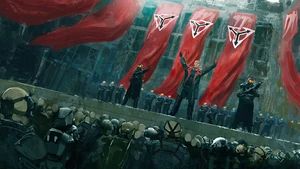
From 2330 to 2350, due to incredibly unfair trade rates enforced by the ISA, Helghan was hit by a major economic depression, leading to widespread poverty and famine across the planet that was not seen for over a century.[1] This grim situation gave rise to Scolar Visari, a highly charismatic politician, who capitalized on the economic crisis and the people's growing anger against the ISA and the Helghan Administration, in which millions from all segments of Helghan society fell under his sway.[1]
In 2347, Visari staged a successful popular coup against the ruling Helghan Administration after feigning an attempt on his own life, and declared himself the "Autarch".[1] Under Visari's rule, he reforged Helghan into a true independent power in which he rebuilt Helghan's economy by breaking the ISA embargo to trade directly to off-world black-market suppliers and unaligned colonies before settling a contract with the ICSA for energy and materials, and drastically enlarging Helghan's military.[1]
Visari further reshaped Helghan society and culture into accepting his ideology of Helghan superiority, claiming that the mutated people to be a new breed of humans superior over regular humans which he dubbed themselves "Helghast".[1] He immediately instigated Helghan into a highly secretive militant state, and a complete media takeover on Helghan. Eventually, Visari re-established hostilities with the ISA in his bid to conquer Vekta and exact revenge on the UCN, and this conflict became now known as the Second Extrasolar War.
Second Extrasolar War[]
In 2357, the Helghast attempted to conquer and subdue Vekta by utilizing two high-ranking traitors within the ISA in order to disable Vekta's SD Defense Network, allowing the Helghast Third Army to land on Vekta without any resistance in space before utilizing the Vektan defense platforms to be use against UCA reinforcements. Although they nearly conquered the planet, ultimately, the invasion failed in preventing the UCA from reinforcing the ISA and the Helghast were pushed off Vekta entirely, but managed to captured ISA nuclear weapons and other advanced weapons. By 2359 the ISA subsequently launched a retaliatory strike against Helghan, establishing a beachhead at Pyrrhus in a bid to capture Scolar Visari and dismantle the Helghast regime.
During the first hours of the ISA invasion, the Helghast forces fanatically defended the capital before utilizing Arc pillars in destroying and delaying the bulk of the ISA ground forces under Avenger Convoy, preventing them from advancing further to Visari Palace and capturing the Autarch. The ISA discovered the Petrusite Grid under the Maelstra Barrens and attempted to destroy it, but was beset by a surprise attack by Helghast forces in a daring raid to obtain the nuclear launch codes for several ISA nuclear warheads captured by the Helghast in their failed invasion of Vekta. During a pitched battle in the skies above Helghan, the Helghast successfully destroyed several ISA cruisers, including the ISA flagship, New Sun.[2] However, the New Sun crashed into the Petrusite Grid as it came down, destroying it and deactivating almost all of Pyrrhus' defenses. Though the city was left vulnerable, the Helghast used the codes they had acquired to detonate a nuclear warhead in Pyrrhus, wiping out the vast majority of the ISA invasion force, and the remaining Helghast forces within the city.[3]
The remaining ISA forces launched a desperate assault on Visari Palace during which they destroyed a massive Arc battery in Visari Square, fighting their way to the palace courtyard and front entrance in a relentless attack. Thereafter, ISA commandos Rico Velasquez and Tomas Sevchenko fought their way through the last of Visari's forces within Visari Palace itself, killing Colonel Mael Radec, military leader of the Helghast troops and personal bodyguard of Scolar Visari himself. Afterwards, Velasquez and Sevchenko stormed Visari's throne room to arrest him, but Visari was killed by an enraged Velasquez. Before he died, Visari swore that he would be seen as a martyr if he was to be killed and that "Helghan will dissolve into chaos", which is exactly what happened.[4] Helghan fell into a power struggle as rivalling political factions rose to claim power left vacant in the wake of Visari's death. The remaining ships of the ISA fleet were either destroyed or withdrew from Helghan entirely, while the ISA troops that weren't able to withdraw were left stranded on Helghan, with no way of receiving any further aid, and no other transportation off Helghan.
With Visari dead, the Helghast military and the main Helghast weapons manufacturer, Stahl Arms, began to wage a political struggle to take control of the Helghast government, while the stranded ISA troops were forced to battle for mere survival. Eventually, the political struggle for control of the Helghast government came to a climax, only made worse by successful operations conducted by the ISA remnants.
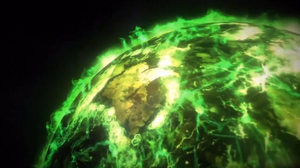
Helghan devastated in the Terracide.
In a meeting between the Helghast military leader (and recently crowned Autarch) Orlock and Stahl Arms chairman Jorhan Stahl, a skirmish erupted between forces led by the two leaders, resulting in the death of Autarch Orlock. This plunged the Helghast race into civil war, allowing the ISA forces to destroy Stahl's experimental cruiser before he could enact his plan to eradicate all life on Earth. The resulting Petrusite explosions set off from Stahl's cruiser destroyed a massive space station, the entire Helghast invasion fleet destined for Earth, and violently irradiated all unprotected life on planet Helghan in which this devastation is later known as the Terracide.[5]
With the ISA forces having escaped Helghan onboard hijacked Helghast ships and currently en route home to Vekta, with at least one, or possibly two most capable successors to Visari's throne killed, and its own homeworld irrevocably devastated by energized Petrusite radiation, the Helghan Empire is totally destroyed.
Post-War Aftermath[]
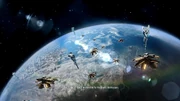
The flight to Vekta
Following the destruction of Helghan, the Empire's surviving population was forced to resettle on Vekta after the ISA granted them refuge, allowing them to colonize half the planet and established the nation of New Helghan, which is led by Visari's daughter, Chancellor Hera Visari. Though defeated, the Helghast bear resentment towards the Vektans, blaming them for causing the Terracide that destroyed their civilization and livelihood. As a result, the Helghast largely refused to assimilate into "human" culture, creating a societal divide between the native Vektans and embittered Helghast. Over the next thirty years this divide would continue to grow and widen, leading to a cold war between Vekta and New Helghan.
Unknown to the public, not every Helghast was evacuated from Helghan. Those that remained on Helghan were united by a still alive Jorhan Stahl, and under the guise of mining operations, prepared for three decades to invade Vekta once again, amassing a vast armada of ships and war materiel hidden under the surface of the planet.
Government[]
The Helghan Empire was a militaristic totalitarian state. It was headed by the Autarch, the supreme leader of the Helghast whose power is absolute with no opposition to their rule. The Autarch was advised by the Helghast Senate, a council of supposedly ten individuals with ties to the Helghast military and other powerful organizations in the Empire's society. Admiral Orlock, commander-in-chief of the armed forces and second Autarch of the Empire served as a member of the Senate and was a close friend of Autarch Visari. Other forms of management beyond the Senate are currently unknown, and unlikely to be seen.
Military[]
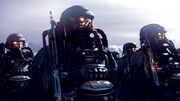
Helghast soldiers.
The Helghast peoples' lives of extreme hardship naturally make them hardened soldiers. Most of Helghan's fiscal and natural resources go towards the military, leaving little for domestic development. The Helghan military's primary tactics primarily relate to the implementation of vicious, rapidly sweeping surgical strikes reliant on the element of surprise, focusing almost completely on offensive based strategies. However, the Second Extrasolar War has shown that the Helghast military is adept in defensive tactics as well, springing numerous traps and ambushes on unwary ISA forces.
Ideology and Society[]
- "When we came to Helghan we were lost, a broken collection of exiles on the verge of death. At first we thought our new world would poison and destroy us. How wrong we were. Helghan saw what was in every one of us, our strength and our indestructible spirit, and made it manifest. The great change was the rebirth of our people. A people fit to stride the stars and shatter our enemies."
- ―Scolar Visari[src]
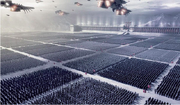
The Helghan Empire's ultra-nationalistic ideals centered on the superiority of the Helghast, a strong military, and total commitment to the Helghast government. Their ideals are symbolized by the Helghast Triad, which emphasizes duty, obedience, and loyalty.[1] The filtration masks ubiquitously worn by the Helghast, once a badge of low station, is valued in the Helghan identity, as Scolar Visari regarded mask-wearing to be a testament to the Helghast's fortitude.[1]
Helghast Superiority[]
Helghast superiority was the main tenant of the Helghan Empire developed by Scolar Visari. Visari stated that the Helghast people are an entirely new and entirely superior race transformed by Helghan's harsh environment; over successive generations the Helghast were biologically adapted to survive Helghan than normal humans: growing lungs to breath and filter the toxic atmosphere, their bodies more suited to the planet's heavy gravity, and their cells more resistant to high radiation levels.[1][6] Visari validates these mutations as proof to his ideology, further stating that not only the Helghast are changed physically stronger but spiritually changed by the hardships they have endured in every circumstance into a "truly living" race.[1]
The Empire was xenophobic towards the Vektan ISA and the Earth-based United Colonial Nations, whom they regarded them as imperialist oppressors who stole Vekta from the Helghast's colonial ancestors.[6] The Helghast's animosity to the Earth-backed Vektans was exacerbated by the strict economic sanctions imposed on Helghan by the ISA that lasted for more than a century. Combined by Vekta's exploitation of Helghan's resources and the planet's inhospitable conditions, the Helghast developed a strong sense of isolation which later turned into otherness.[7] Visari shaped the Helghast's age-old feelings of grievance into a sense of purpose, giving them pride in their past and belief in their future, to reclaim the Helghast's rights that were lost in the First Extrasolar War by force.[6][7]
Human Rights[]
- "We are prisoners of war! We have rights! You have violated the Stockholm Treaty!"
"Stockholm? What planet do you think you're on?!" - ―Jason Narville to Jorhan Stahl[src]
Helghan brutality is widely accepted in their society. They do not hesitate to execute those who are not born up to standards, speak against the government or who sympathize with humanity. Prior to the invasion of Vekta, there were moderates and conscientious objectors in Helghan society in which most of them have been executed as traitors or driven underground.[8] Visari urged his citizens in turning in dissenters to the authorities in order to reeducate them and "expunge their weakness for the greater good."[9]
During the Second Extrasolar War, Helghan atrocities were quite prevalent against Vektan prisoners of war and civilians. In Killzone 3, Stahl Arms mercenaries are seen executing surrendering ISA troops on the spot, or even shooting them when their backs are turned. Prisoners of the Helghast are often tortured to death or even used as unwilling test subjects for a number of agonizingly fatal experiments. Live public executions are also practiced.
Militarism[]
- "The path we have chosen is not an easy one. Struggle is the father of all things and true virtue lies in bloodshed. But we will not tire, we will not falter, we will not fail! In the blood of our warriors comes the price we must pay. Blood alone moves the wheels of history. And we will be resolute! We will fear no sacrifice and surmount every difficulty to win our just triumph!"
- ―Scolar Visari[src]
The military is above all the most prized element of the Helghan Empire. The vast majority of the Helghan Nation's resources are spent on the military and Visari's propaganda-related structures in Pyrrhus, leaving very little for the average Helghast civilian's well-being. Also, many high ranking officials in the Helghast military hold very little compassion for their own soldiers, or even Helghast civilians in general, let alone any shown to the people of Vekta and anywhere else in the galaxy. The Helghast military's extensive damage inflicted towards Vekta, and the detonation of a nuclear weapon in their own capital of Pyrrhus shows their deep hatred for human life and complete disregard for collateral damage, only having a total commitment to their objectives no matter the cost.[10]
Alphabet[]
The Helghast use their own form of a symbol alphabet, similar to Eastern Asian written languages.[1] Visari implemented this system claiming it was an attempt to control speech by restricting the use of 'outmoded' Earth alphabets. This is actually a form of newspeak, designed to dissuade alternative thinking, as there is no symbol for 'surrender'.[11]
Trivia[]
- "The history of the Helghan race draws inspiration from lots of different real-life sources, but there isn't a sole historical event that served as the main inspiration for the Helghan race. We wanted to create a race that would echo all the great bad guys from our own history. The Helghast are a pastiche of Hitler's Germany, Stalin's Russia, Mussolini's Italy, etc, etc. The core idea behind the first Killzone was that it was World War 2 in Space, so at the end of the day the easiest way to describe them would be as Space Nazis."
- ―Jan-Bart van Beek[src]
- Guerrilla Games had confirmed that the Helghast were inspired by various oppressive regimes and totalitarian states throughout the twentieth century, which include the Soviet Union under Josef Stalin, China under Mao Zedong, and most especially Nazi Germany. Scolar Visari's cult of personality is based on Stalin; much of the Helghast's society, imagery, military doctrine and attire strongly evokes images of Nazi Germany.[12] In fact the term "Space Nazis" is a Killzone fan-coined term referring to the Helghast. Guerrilla Games's Dutch key members in its visual design team conceptualized their creation of the Helghast from hearing stories about the Nazi-occupation of the Netherlands.[13]
- As a result, most, if not all Helghan weaponry are visually based on weapons made and used by the Nazi forces during World War II. An example of this is the MG-42-inspired StA-3 LMG.
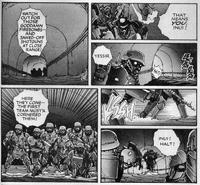
The Special Armed Garrison from Kerberos Panzer Cop.
- The Helghan written language was drawn from a variety of glyphs and characters including Norse runes, Korean Hangul, and the Cyrillic alphabet. It's a syllabic alphabet, similar to Japanese and Korean, in which each character stand for a syllable and not for a letter.[12]
- There are similarities between the Helghast soldiers' attire and the Protect-Gear created by Japanese mechanical designer Yutaka Izubuchi from the Kerberos Saga. But there's no evidence to suggest they are a direct inspiration as Guerrilla Games stated nothing to confirm or deny it.[14]
- Most Helghast speak with a multitude of different British accents. Regular troops have an east London or Welsh accent, Shock troops and a few commanding figures such as Colonel Armin Metrac speak in a central London dialect, while their Autarch Scolar Visari (voiced by Brian Cox) has a Scottish voice. There has been criticism from UK fans towards the Helghast seen in the titles prior to Killzone Shadow Fall as the Helghast all have British accents and following similar ideas to the Nazi Party.
Related[]
References[]
- ↑ 1.00 1.01 1.02 1.03 1.04 1.05 1.06 1.07 1.08 1.09 1.10 1.11 1.12 Timeline retrieved from the official Killzone website
- ↑ Killzone 2, campaign level The Cruiser
- ↑ Killzone 2, campaign level Maelstra Barrens
- ↑ Killzone 2, campaign level Visari Palace
- ↑ Killzone 3, campaign level Interception
- ↑ 6.0 6.1 6.2 Why We Fight
- ↑ 7.0 7.1 Briefing #573968
- ↑ Killzone 3: The Official Guide: JVB: "No, there are moderates and conscientious objectors in Helghan society, but most of them have been driven underground or labelled as traitors and executed prior to the Helghast Invasion of Vekta. Gregor Hakha, one of the main characters in the first Killzone game, was a defector who used to be Chief of Staff in the Helghast army."
- ↑ Helghast Propaganda in Search and Retrieve
- ↑ Killzone: Ascendancy, p. 76: "With the ascent of Scolar Visari, Helghan had reconfigured itself into a society that glorified combat and exalted military victory above all things, no price being too high to pay in order to secure Helghast dominance, no sacrifice too great."
- ↑ Killzone 3: The Official Guide: JVB: "When he first came to power, Visari attempted to control speech by restricting the use of 'outmoded' Earth alphabets. It was actually a form of newspeak, designed to dissuade alternative thinking. For example, the new Helghast writing system doesn't have a symbol for 'surrender'."
- ↑ 12.0 12.1 Killzone 3: The Official Guide
- ↑ Killzone Visual Design
- ↑ Ruh, Brian. (24 October 2018). "Illang, Jin-Roh and the Kerberos Saga: A Brief History of the Dogged Pursuit of Justice". Anime News Network.
